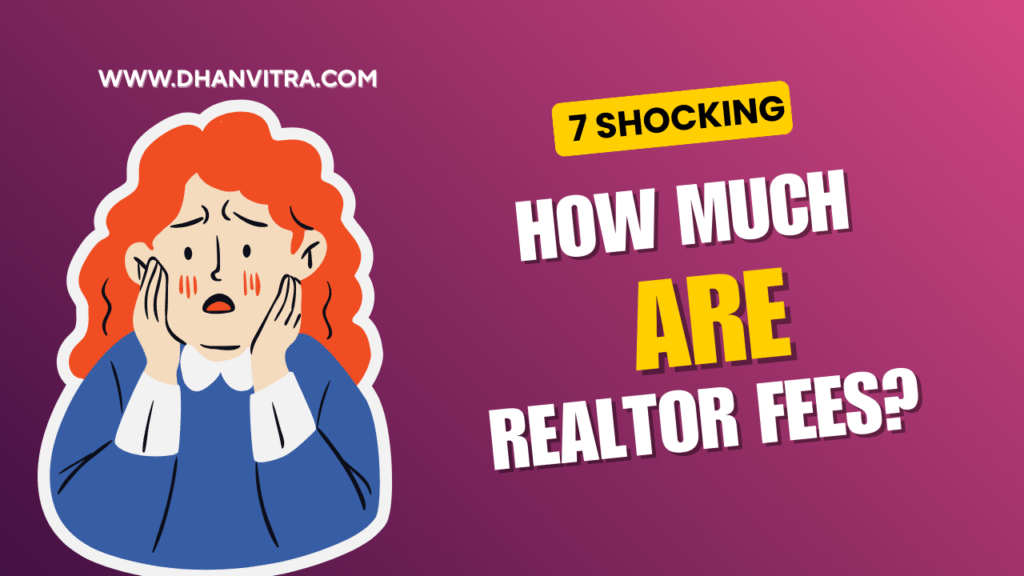
Welcome to Dhanvitra, your trusted hub for clear, practical financial insights. If you’ve ever dipped your toes into buying or selling property, you already know the process can be overwhelming — and one of the biggest mysteries is realtor fees. These costs, often hidden behind percentages and commissions, can significantly impact the profit you make on a sale or the price you pay for your dream home.
At Dhanvitra, we believe knowledge is power. That’s why we’re breaking down the real story behind realtor fees in this guide: “How Much Are Realtor Fees? 7 Shocking Truths You Must Know.” Understanding how commissions work isn’t just for industry insiders — it’s essential for anyone looking to make smarter, more profitable property decisions.
Whether you’re a first-time buyer, a seasoned investor, or simply curious about the hidden costs of real estate, this article will help you see why realtor fees matter and how they can shape your financial outcome. By the end, you’ll know exactly what to watch for, how to negotiate smarter, and how to keep more of your hard-earned money in your pocket.
Table of Contents
What Are Realtor Fees?
Realtor fees are the payments made to real estate professionals for their expertise in guiding you through buying or selling property. Think of them as the price for having a skilled navigator when you’re traveling through unfamiliar territory. Instead of charging an hourly rate, most realtors earn their income from commissions — a percentage of the final sale price of a property. Globally, this percentage varies widely, but the concept is similar: you’re paying for marketing, negotiation skills, and market knowledge.
In many countries, these fees cover activities such as advertising the property, hosting open houses, coordinating viewings, handling paperwork, and negotiating offers. The goal is to make a complicated process seamless for you. While it might feel like a big cost upfront, a good realtor can often secure a better price or smoother deal, offsetting their fee.
Shocking Truth #1 – Realtor Fees Are Negotiable
One of the most misunderstood aspects of real estate is the belief that commissions are fixed by law or industry standard. This is far from reality. Around the world, realtor fees are almost always negotiable, though how flexible they are depends on the market and the individual agent.
For example, if you’re selling a high-value home in a competitive city like Toronto or Dubai, you may have more leverage to negotiate a lower percentage than someone selling a small condo in a slower market. Agents often adjust their rates based on the effort they expect to invest — such as marketing costs, time commitment, or anticipated demand.
Negotiating doesn’t have to be uncomfortable. Start by asking the agent to explain their fee structure. Compare multiple agents and their services, not just their percentages. Some will offer tiered pricing, where you pay less for a basic listing and more for full-service marketing. The key takeaway is simple: you have the right to ask, and often you’ll save thousands by doing so.
Shocking Truth #2 – Buyer’s Agent and Seller’s Agent Split the Commission
In most real estate markets, it’s common practice for the seller to pay the full commission, which is then divided between the seller’s agent and the buyer’s agent. For instance, if the total commission is 5%, the seller’s agent might take 2.5% and give 2.5% to the buyer’s agent.
This arrangement can create the illusion that buyers aren’t paying anything for their agent’s services — but in reality, the cost is usually built into the sale price. Buyers effectively contribute to these fees when they purchase the property, even if they never see an invoice for it.
Globally, this structure can vary. In some countries, buyers pay their agents directly; in others, agents work solely for the seller and charge higher rates. Understanding who pays what in your market helps you budget more accurately and negotiate smarter deals.
Shocking Truth #3 – Different Countries, Different Fee Structures
The real estate industry looks different depending on where you are in the world, and so do realtor fees. In the United States, for example, commissions typically range from 5% to 6% of the sale price. In the United Kingdom, costs are dramatically lower, often 1% to 2%, because the market is more transparent and less agent-driven. Meanwhile, countries like Australia and Canada sit somewhere in between, averaging 2% to 3%.
In some parts of Europe, buyers and sellers each pay their own agent, creating a more balanced cost-sharing system. In Japan, there’s even a legal formula for calculating real estate commissions. And in emerging markets, such as parts of Southeast Asia or Africa, fees can be negotiable to the point of being unrecognizable compared to Western norms.
The key takeaway for global readers is this: never assume the fee structure in your country is standard elsewhere. If you’re relocating or investing overseas, research the local norms so you aren’t caught off guard. This knowledge can give you an edge, especially if you’re entering a market with lower or more flexible commissions.
Shocking Truth #4 – Discount Brokers and Flat Fees Are Real Options
The old days of being locked into a 6% real estate commission are gone. In many markets worldwide, discount brokers and flat-fee services are rewriting the rules. Instead of paying a hefty percentage of your home’s selling price, you can choose a broker who charges a flat amount or a deeply discounted rate.
For example, in the U.S., companies like Redfin or Purplebricks (in the UK and Australia) offer tiered or flat-fee pricing models. This means you pay a predictable cost — say $3,000 or $5,000 — regardless of whether your property sells for $250,000 or $750,000. These models can be especially attractive in hot housing markets where homes sell quickly and with less marketing effort.
Globally, the rise of these services signals a shift in consumer power. Sellers are realizing they don’t always need the full-service model, especially if they’re confident about staging, photography, or hosting their own open houses. By using discount brokers or flat-fee models, you can significantly reduce your selling costs and still gain access to essential services like MLS (Multiple Listing Service) exposure, contracts, and basic marketing support.
The key is understanding what’s included. Some flat-fee services may not handle negotiations or closing paperwork, so you need to know where you’re saving money and where you may need to invest more effort yourself. But if you’re comfortable taking on some of the responsibilities, you can save thousands — without sacrificing visibility or professionalism.
Shocking Truth #5 – Hidden Costs You Didn’t Know About
Realtor commissions aren’t the only money flowing out of your pocket during a property sale or purchase. Hidden costs can sneak up on you, whether you’re in Toronto, Sydney, Mumbai, or Berlin. These costs go beyond the percentage your agent charges and often aren’t clearly disclosed upfront.
Take marketing, for example. Professional photography, 3D tours, or premium online listings may cost extra — sometimes hundreds or thousands of dollars — depending on your market. Then there are administrative fees, “transaction fees,” or paperwork charges. Some agents include these in their commission; others tack them on as separate bills.
Staging costs are another surprise. Many sellers don’t realize how expensive it can be to rent furniture, décor, or even hire a staging consultant. While staging can increase the sale price, it’s an added cost that may not have been in your original budget.
Globally, these hidden costs vary wildly depending on local customs and regulations. In some countries, sellers are responsible for government-mandated inspections or certificates, while in others, buyers foot the bill. The bottom line? Always ask for a complete cost breakdown before signing any agreement with an agent. Clarity upfront can save you from headaches later.
Shocking Truth #6 – Technology Is Driving Down Costs
Technology is changing real estate faster than almost any other industry. Platforms like Zillow, MagicBricks, or Zoopla have made it easy to list, view, and compare homes without needing an agent at every step. Virtual tours, drone photography, and AI-driven pricing tools mean you can do much of the research yourself, cutting down on an agent’s workload — and potentially their commission.
In many countries, online platforms have even introduced self-service listing options where homeowners can directly list their properties and handle inquiries themselves. This not only saves money but also gives sellers more control over how their property is marketed.
For agents, the digital revolution has reduced time spent on tasks like finding leads, scheduling showings, and creating marketing materials. As a consumer, you can use this leverage to negotiate lower fees. If an agent can process more listings thanks to tech, there’s no reason they can’t also reduce their commission to stay competitive.
The global trend is clear: technology empowers buyers and sellers with more information than ever. Armed with data and tools, you’re no longer a passive participant — you’re in the driver’s seat when it comes to negotiating costs and making informed decisions.
Shocking Truth #7 – Paying More Doesn’t Always Mean Better Service
There’s a widespread belief that a higher commission equals a better agent. In reality, that’s not always the case. Globally, some of the most effective agents charge competitive or even discounted rates but offer exceptional service because they’re efficient, tech-savvy, and experienced.
The real difference between a great agent and an average one is their expertise, negotiation skills, and marketing strategy — not how much they charge. An agent could charge 6% and still be inattentive, slow, or ineffective. Meanwhile, another could charge 3% and deliver stunning photography, excellent staging guidance, and lightning-fast communication.
Before agreeing to any fee, ask about their track record. How many homes have they sold in your area? What’s their average time on market? How do they handle negotiations? These questions are far more important than the percentage alone.
In global markets, you’ll also find cultural differences in service expectations. In some countries, agents provide full concierge-level support for a small commission. In others, they focus on basic listing services but charge a premium. The bottom line is to judge an agent by results, not by their fee structure.
By taking the time to research and compare agents, you’ll quickly see that the highest fee isn’t always the smartest choice. What you’re paying for is expertise, strategy, and results — not a price tag that simply looks “premium.”
How to Calculate Realtor Fees for Your Property
Calculating realtor fees may look like simple math, but it’s often misunderstood because of the different ways commissions are split and applied. Globally, most agents still work on a percentage of the final sale price, but that percentage can vary widely — from 1% in some European markets to 6% or more in parts of North America.
To start, identify the agreed commission percentage. For example, if your property sells for $400,000 and the commission rate is 5%, the total commission is $20,000. This sum is usually shared between the listing agent and the buyer’s agent. However, your region might calculate things differently — some countries add VAT or other taxes, some agents charge an up-front fee plus a smaller commission, and some include marketing costs separately.
The easiest way to handle this globally is to run “what-if” scenarios. Plug your property’s estimated sale price into an online calculator or spreadsheet. Test different commission percentages (say, 3%, 4%, 5%) to see how much you’d pay in each case. Doing this gives you leverage when you’re negotiating, because you’ll know exactly how a half-percentage difference impacts your wallet. In competitive markets or when selling high-value property, even a 0.5% reduction could save you thousands of dollars or pounds.
Tips for Reducing Realtor Fees Without Sacrificing Quality
Lowering your realtor fees isn’t about squeezing your agent dry; it’s about creating a win-win arrangement. The first step is to discuss your goals openly. Explain to the agent you’re price-sensitive but also value strong marketing and negotiation skills. Many agents are willing to reduce their commission if you bring something valuable to the table — such as a highly desirable property, a quick closing, or a referral to other clients.
Another global tactic is to request a performance-based commission. For example, you might agree to pay 4% if the home sells at or below a target price but 5% if the agent secures a higher-than-expected sale price. This rewards the agent for achieving better results while protecting you from overpaying.
Bundling services can also trim costs. In some regions, photography, staging, or legal paperwork are included; in others, they’re extra. If you handle some of these tasks yourself — like staging your own home or providing your own professional photos — your agent may agree to a reduced commission. Similarly, selling off-market or using hybrid online platforms (which let you handle showings while an agent manages paperwork) can significantly cut costs while keeping the expertise you need.
Finally, don’t forget timing. Listing your property during high-demand seasons can make your home easier to sell, which puts you in a stronger position to negotiate fees.
Common Misconceptions About Realtor Fees
Realtor fees are surrounded by myths that cost people money and peace of mind. One of the biggest misconceptions is that buyers don’t pay commissions. While the seller technically writes the check, the cost is usually built into the purchase price. This means buyers indirectly pay the commission because the home would likely be priced differently if no commission were involved.
Another widespread myth is that higher commissions guarantee faster sales or better results. In reality, the success of a sale depends far more on pricing strategy, marketing exposure, and the agent’s negotiation skills than on the commission percentage. A lower-commission agent with an exceptional marketing plan may outperform a higher-priced agent relying on outdated methods.
A third misconception is that realtor fees are legally fixed. In most countries, commissions are negotiable. There are common ranges, but no universal “set” fee. Sellers and buyers often fail to negotiate simply because they think it’s impolite or impossible. The truth is, commissions are like any other professional service fee — open to discussion.
Lastly, some people believe that skipping an agent entirely saves money automatically. While this can work for experienced sellers, it also shifts all the work and legal risk onto you. In some regions, the added stress or potential legal mistakes can cost far more than the commission you were trying to save. The key is to understand what you’re paying for, and whether that value matches your needs.
Real-Life Examples of Realtor Fees
Let’s put all the theory into a real-world context. Imagine you’re selling a suburban house in the U.S. valued at $500,000. With an average commission rate of 5%, your total realtor fees would come to $25,000. This fee is usually split between the seller’s agent and the buyer’s agent, so each would typically receive $12,500. Even a small change in the commission rate (say, negotiating down to 4.5%) could save you $2,500 instantly.
Now think about London. A two-bedroom apartment priced at £500,000 would likely have an estate agent’s fee of around 1.5% — about £7,500. This is far lower than the U.S., but the same principles apply. Negotiating, asking for a clear breakdown of costs, and understanding your options can still make a big difference.
In Australia, selling a property worth AUD 700,000 at an average commission of 2.5% would mean paying AUD 17,500 in fees. That’s a substantial chunk, but again, many Australian agents offer tiered commissions or flat-fee options that can lower your costs if you shop around.
These examples highlight a global truth: realtor fees vary wildly depending on where you live, but the power to question and negotiate them is universal. Whether you’re in Canada, Singapore, or South Africa, the same logic applies — know your numbers before signing on the dotted line.
Conclusion – Making Smart Decisions About Realtor Fees
Realtor fees don’t have to be a mystery or a financial burden. The key is to go into the process informed and confident. Understand how commissions are structured in your region, ask the right questions, and never assume fees are fixed. Technology, new business models, and the rise of online real estate platforms have shifted the landscape in favor of consumers, meaning you now have more leverage than ever before.
Think of realtor fees as a business deal rather than a flat tax. When you hire an agent, you’re essentially investing in a marketing and negotiation expert. That means you can, and should, shop around for the best combination of cost, experience, and service quality. Whether you choose a full-service agent, a discount broker, or a hybrid online model, your ultimate goal is the same — to sell or buy your property at the best possible price with the least possible cost.
Making smart decisions about realtor fees isn’t just about saving money. It’s about regaining control in one of the biggest financial transactions of your life.
FAQs About Realtor Fees
How Much Are Realtor Fees?
Globally, realtor fees range widely — from about 1% to 6% of the property’s sale price. In the U.S., 5–6% is common, while in the U.K. it’s closer to 1–2%. Always check the norms in your local market.
Who actually pays the realtor fees?
In most cases, the seller pays the commission, which is then split between the buyer’s and seller’s agents. However, this cost is indirectly baked into the sale price, meaning the buyer ultimately contributes as well.
Are realtor fees negotiable?
Yes. Fees are almost always negotiable. You can ask for a reduced percentage or agree to a performance-based commission tied to how quickly or how high your property sells.
Do online real estate platforms reduce fees?
Often, yes. Online or hybrid brokerages use technology to streamline the process, which can lead to lower fees or flat-rate packages while still providing key services like MLS listings and contract support.
Does paying more guarantee better service?
Not necessarily. A higher commission doesn’t automatically mean a better outcome. The agent’s marketing strategy, experience, and track record are far more important indicators of success than the commission rate alone.









